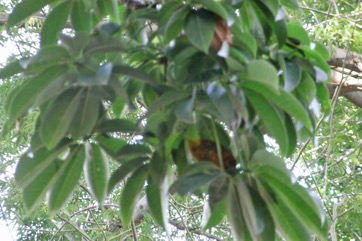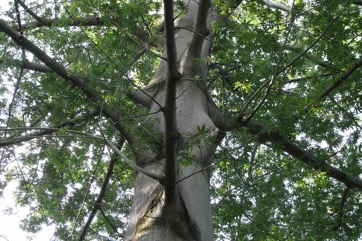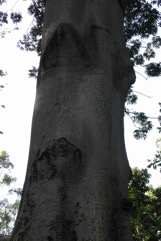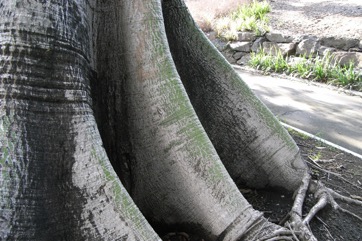Red-flowered silk cotton tree

It is a tropical plant. A savannah tree. It grows in the Sahel. It grows in open savannah woodland especially in rocky places. It can grow in arid places. In Brisbane Botanical Gardens.
Also known as:
Agougou, Belofa, Bregue, Bumbum, Bunkungo, Buufore, Djoe, Djohi, Djoia, Fula, Garablaobe, Genger, Kapokier rouge, Karayah, Kattupa, Kuriga, Kuruhi, Kurya, Luncum, Mikikireck, Mufo, Polom-fidalgo, Polom-foro, Sumauma, Tikonfaati, Ulofo, Veekou, Velta, Voaka
Synonyms
- Possibly Bombax buonopozense
Edible Portion
- Flowers, Fruit, Leaves
Where does Red-flowered silk cotton tree grow?
Found in: Africa, Australia, Benin, Burkina Faso, Cameroon, Central Africa, Central African Republic, CAR, Chad, Ghana, Guinea, Guinée, Guinea-Bissau, Mali, Niger, Nigeria, Sahel, Senegal, Sierra Leone, Togo, West Africa
Notes: There are about 8-20 Bombax species. Also put in the family Bombacaceae.
Growing Red-flowered silk cotton tree
Cultivation: Plants are grown from seed. Seed need treatment before planting. They can also be grown from suckers.
Edible Uses: The flowers are dried and used in sauces. The young fruit are cut and dried and then used in dishes. The leaves are cooked and used as a vegetable.
Nutrition Info
per 100g edible portion| Edible Part | Energy (kcal) | Protein (g) | Iron (mg) | Vitamin A (ug) | Vitamin c (mg) | Zinc (mg) | % Water |
|---|---|---|---|---|---|---|---|
| - | - | - | - | - | - |
Red-flowered silk cotton tree Photos




References
Achigan-Dako, E, et al (Eds), 2009, Catalogue of Traditional Vegetables in Benin. International Foundation for Science.
Alyegba, S. S. et al, 2013, Ethnobotanical Survey of Edible Wild Plants in Tiv Communities of Benue State, Nigeria. Journal of Natural Sciences Research. Vol.3, No.7
Assogbadjo, A. E. et al, 2013, Specific Richness and Cultural Importance of Wild Edible Trees in Benin. Acta Hort. 979, ISHS 2013
Batawila, K., et al, 2007, Diversite et gestion des legumes de cueillete au Togo. African Journal of Food, Agriculture, Nutrition and Development 7( 3& 4): 64
Belem, B., et al, 2007, Use of Non Wood Forest Products by local people bordering the “Parc National Kaboré Tambi”, Burkina Faso. The Journal of Transdisciplinary Environmental Studies vol. 6, no. 1 p 9
Belem, M., et al, 2017, Strategy of Conservation and Protection of Wild Edible Plants Diversity in Burkina Faso. ANADOLU 27 (2) 2017, 82- 90
Bodkin, F., 1991, Encyclopedia Botanica. Cornstalk publishing, p 154
Bonou, A., et al, 2013, Valeur economique des Produits Forestiers Non Ligneux (PFNL) au Benin. Editions Universitaires Europeennes p 92
Catarino, L. et al, 2019, Edible Leafy Vegetables from West Africa (Guinea-Bissau): Consumption, Trade and Food Potential. Foods 2019, 8, 493
Codjia, J. T. C., et al, 2003, Diversity and local valorisation of vegetal edible products in Benin. Cahiers Agricultures 12:1-12
Dansi, A., et al, 2008, Traditional leafy vegetables and their use in the Benin Republic. Genet Resour Crop Evol (2008) 55:1239–1256
Gaisberger, H., et al, 2017, Spatially explicit multi-threat assessment of food tree species in Burkina Faso: A fine-scale approach. PLoS ONE 12 (9): e0184457
Gallagher, D. E., 2010, Farming beyond the escarpment: Society, Environment, and Mobility in Precolonial Southeastern Burkina Faso. PhD University of Michigan.
Gilbert, T., et al, 2017, Diversity and local transformation of indigenous edible fruits in sahelian domain of Cameroon. Journal of Animal & Plant Sciences Vol. 26 (2): 5289-5300
Glew, R. H., et al, 1997, Amino Acid, Fatty Avid and Mineral Composition of 24 Indigenous Plants of Burkina Faso. Journal of Food Composition and Analysis 10, 205-217
Guinko, S. & Pasgo, L. J., Harvesting and marketing of edible products from local woody species in Zitenga, Burkina Faso. Unasylva - No. 168
Hanawa, Y., 2013, Wild edible plants used by Guiziga people of far northregion of Cameroon. Int. J. Med. Arom. Plants. Vol 3 (2) : 136-143
Keay, R.W.J., 1989, Trees of Nigeria. Clarendon Press, Oxford. p 138
Kristensen, M and Lykke, A. M., 2003, Informant-Based Valuation of Use and Conservation Preferences of Savanna Trees in Burkina Faso. Economic Botany, Vol 57, No. 2, pp. 203-271
Lykke, A. M., Mertz, O, and Ganaba, S., 2002, Food Consumption in Rural Burkina Faso, Ecology of Food and Nutrition, 41:119-152
Maiga, A., et al, 2005, Determination of Some Toxic and Essential Metal Ions in Medicinal and Edible Plants from Mali. Journal of Agricultural and Food Chemistry 53: 2316-2321
Maydell, H. von, 1990, Trees and shrubs of the Sahel: their characteristics and uses. Margraf. p 189
Mertz, O., Lykke, A. M., and Reenberg, A., 2001, Importance and Seasonality of Vegetable Consumption and Marketing in Burkina Faso. Economic Botany, 55(2):276-289
Morley, B. & Everard, B., 1970, Wild Flowers of the World. Ebury press. Plate 57
Segnon, A. C. & Achigan-Dako, E. G., 2014, Comparative analysis of diversity and utilization of edible plants in arid and semi-arid areas in Benin. Journal of Ethnobiology and Ethnomedicine 2014, 10:80
Vanderjagt, F. J., et al, 2000, The trypsin inhibitor content of 61 wild edible plant foods of Niger. Plant Foods for Human Nutrition 55: 335–346, 2000.
World Checklist of Useful Plant Species 2020. Royal Botanic Gardens, Kew
www.worldagroforestrycentre.org/treedb/